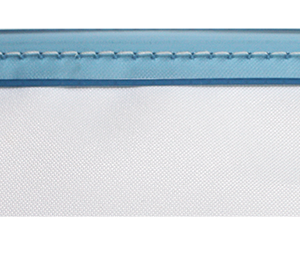
What is Silicone Tape?
Soft Signage has changed dramatically over the past 15 years, and the introduction of silicone tape to the finishing of fabrics for signage has transformed visual merchandising for a generation of retailers. The transition to stretch frame fabrics or SEG (Silicone Edge Graphics), reduced the cost of distribution, the need for installers, increased the cycle of graphics change due to the ease of which the retailer or exhibitor could swap in a new graphic.
The silicone tape is sewn onto the rear edge of the fabric graphic, and folded into a gap (rebate) around the perimeter of an aluminium frame, thereby stretching the fabric taut, and presenting a printed canvas link, quality image, with minimal fuss and effort. Many systems used silicone tape: ReFrame®, RexFrame®, Matrix®, FabFrame®, Tuffline® and many others.
However the name, “Silicone Tape” is actually used to cover a few different types of tape. I’ve worked with “Silicone Tape” made from PVC, labelled as “Hard” or “Soft”, I’ve used tapes made from Rubber and also, of course, made from silicone. There are even self adhesive tapes that eliminate the need to sew the tape to the fabric.
So what worked best?
Well in my experience, the perfect tape, has a little bit of stretch; not to much, just enough give to get you the extra 2 or 3mm you sometimes need to stretch a fabric into a frame. The tape should be pliable enough that it allows the fabric to fold, and for the needle of the sewing machine to go through without too much work. If the tape is too rigid and the material too hard, then the needle can snap, or overheat, and when it overheats it will break the thread.
I didn’t like tapes that were too stretchy, because it caused the fabrics to pucker, and gather.
Sometimes a tape would be supplied coated in a release dust, a bit like a talcum powder, and that was unpleasant to work with, as it got over everything, and especially marked black prints.
Other times, a tape would be supplied without any release powder, and the tape would stick together (blocking), which would render it unusable.
The other issue is the size of tape required, and it pays to check the frame supplied, and where your client sourced their original frame from. You see, there are frame systems in the market that use a 10 x 1.5 (mm w x h) tape, and others using a 14 x 3 tape. Neither tape will work in the other extrusion.
The most common size I worked with was a 14mm width. I choose to use a 2.5mm thickness, as it allowed the fabric to slot into the frame just a little bit easier and smoother.





